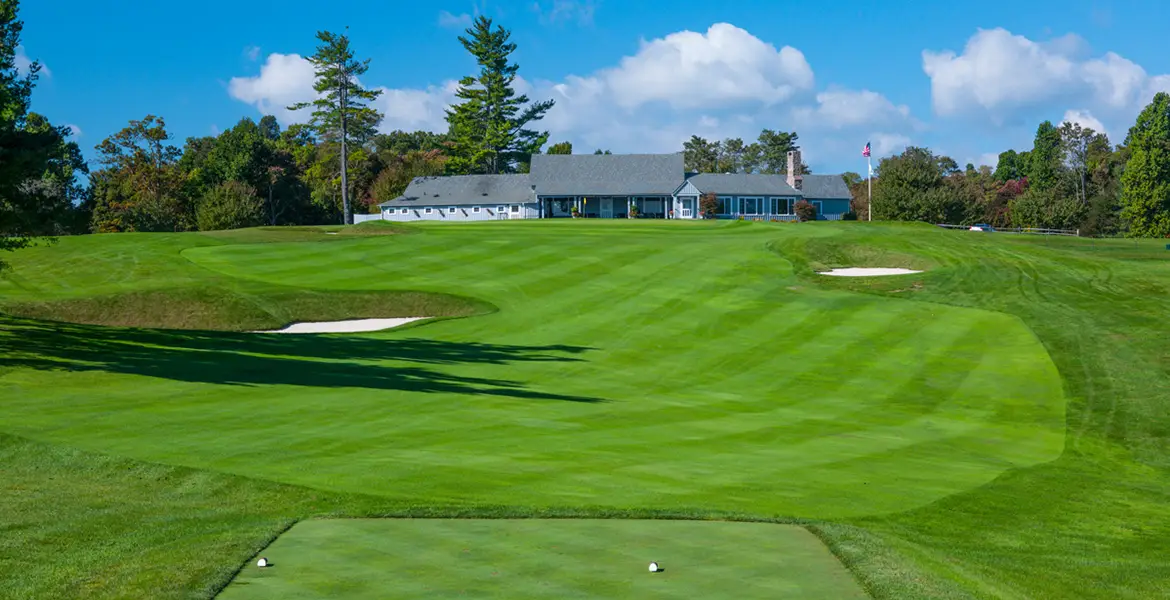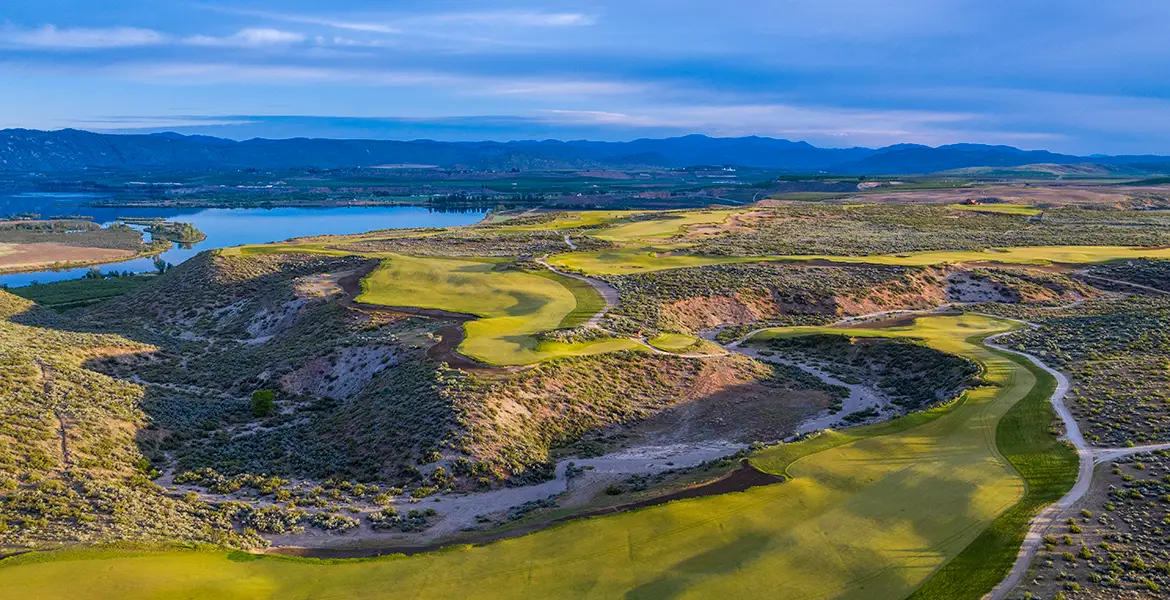From burns and creeks to lakes and ponds, golf courses are full of water hazards. Consequently, they’re also home to bridges of all shapes, sizes, and significance. Here, we spotlight nine noteworthy examples chosen for their history, their appearance, or simply for how a golfer is likely to feel when crossing it.
The Old Course (St. Andrews, Scotland)
Say what you will about predictability, but any story that celebrates famous, memorable, or noteworthy bridges in golf has to include the Swilcan Bridge at St. Andrews. Built in 1835, the ancient stone structure was originally known simply as the “Golfers’ Bridge,” though it was eventually renamed to share the moniker of the burn that it crosses. Although far from imposing, the Swilcan Bridge is actually bigger than it appears. In 1869, Old Tom Morris re-banked the Swilcan Burn and built up the area around it. In doing so, he buried stretches of the bridge on both sides of the burn. Today, almost half of the bridge is hidden underground.

Augusta National Golf Club (Augusta, Ga.)
As golf bridges go, the stone overpass just to the left of the 12th green at Augusta National is arguably the world’s second most famous bridge after the Swilcan. Dedicated to Ben Hogan in 1958, the Hogan Bridge is adorned with a plaque commemorating Hogan’s 72-hole scoring record of 274 during the Masters in 1953, which many at the time believed would never be beaten.

Yet, Augusta National is home to two other dedicated footbridges that are worthy of a spotlight. A stone structure similar in appearance to the Hogan Bridge crosses Rae’s Creek just off the 13th tee box and was dedicated to Byron Nelson on the same day. The Nelson Bridge—and its adorning plaque—commemorates Nelson’s 1937 Masters victory, during which he birdied the 12th hole and eagled the 13th, picking up six strokes on the leader.
Two holes later, players walk across the Sarazen Bridge, a stone walkway that runs adjacent to the pond that guards the front of the 15th green. The bridge was unveiled in 1955 and commemorates Gene Sarazen’s albatross on the hole in 1935. Years later, Sarazen acknowledged that his holed 4-wood from 235 yards was “a piece of luck.” Nevertheless, it was immediately dubbed the “shot heard round the world.”
Sleepy Hollow Country Club (Briarcliff Manor, N.Y.)
It should come as no surprise that Sleepy Hollow Country Club in New York’s Westchester County embraces the narrative penned by Washington Irving more than two centuries ago. The famous American short story, written at the height of the romantic period, not only introduced the now-famous headless horseman, it also put the village of Sleepy Hollow on the map. The private club’s logo depicts that ominous specter, while Sleepy Hollow’s 3rd hole, aptly named “haunted bridge,” brings the frightful scenes from the written page to the golf course.
When playing the par three, golfers must walk across a long, rickety-looking wooden bridge that forks at its halfway point. Perched above a natural quarry, the bridge is defined by its portentous appearance. It truly looks like the place where spirit encounters could transpire. Irving would be proud.
View this post on Instagram
A post shared by EVAN SCHILLER Golf Photography (@evan_schiller_photography)
Bel-Air Country Club (Los Angeles, Calif.)
It’s a major understatement to say that the topography that George C. Thomas had to work with when designing Bel-Air Country Club was severe. The course is laid out through a series of canyons, which required a tunnel be dug to connect two holes, an elevator used after the front nine, and a striking suspension bridge built to transport players from tee to green on the par-three 10th hole. “If I suggested that to a client today,” Tom Doak once told the USGA, “they would think I was kidding.”
The elevator up to the clubhouse (and the 10th tee box) may be the most unusual form of player transport on the course, but the walk across that aforementioned suspension bridge is undeniably the most memorable. As suspension bridges go, it bounces and moves a bit as players cross it. It also serves as a dramatic background for players hitting their approach shots to the green on 18.
View this post on Instagram
A post shared by EVAN SCHILLER Golf Photography (@evan_schiller_photography)
Streamsong Blue (Bowling Green, Fla.)
When standing on the tee box of the 7th hole on Streamsong Blue, players aren’t likely to see or pay much attention to the bridge that links the teeing grounds to the well-protected putting surface. Nor should they. In that moment, the task at hand at the Blue’s signature par three is daunting—the shot can play as long as 203 yards from the elevated back tees and requires a ball be hit over water to an aggressively bunkered green carved out of a scrub-covered hillside.
Those who successfully hit the green are rewarded further with a walk across that aforementioned bridge with a putter in hand. In that moment, they’ll likely feel like a conquering hero—an emotion that they might just relive on their walk back across the bridge (and on the way to the 8th tee), provided they holed their putt.

Kingsbarns Golf Links (St. Andrews, Scotland)
If you weren’t paying attention during the final stretch of your round at Kingsbarns, you could easily overlook “The Brig”—an arched bridge over the Cundie burn that runs just in front of the green complex on the 18th hole. Admittedly, The Brig isn’t much to look at, but it’s historically significant, as it was built in the 1700s as a passage to transport harvested grain from the fields to the “king’s barns” that were located on property. In fact, when early construction of Kingsbarns Golf Links began, the bridge (and sections of the original Kingsbarns course, circa 1823) was discovered as the site was being graded, so architect Kyle Phillips redesigned a portion of the 18th hole to accommodate for those revelations.
The heroic approach to the 18th at Kingsbarns achieves a neat trick of looking much harder than it plays. Visually intimidating but it's a big target and the burn in front is sometimes recoverable, still a thrilling shot. Spectacular. pic.twitter.com/If3SO24wqM
— Adrian Logue (@AdrianLogue) February 9, 2019
Rolling Green Golf Club (Springfield, Pa.)
Eleven years after the Rolling Green Golf Club opened just west of Philadelphia, a bridge was built down the left side of the 13th hole, which allowed golfers to access the elevated putting surface during the off season. Prior to that, a temporary green had to be employed, since the hillside would get too muddy for golfers to walk up. Today, many members still use the bridge, though some prefer to walk up the slope or the path on the right side of the hole, only because a walk over the historic structure stirs up their fear of heights.
Nuevo Vallarta (Nuevo Vallarta, Mexico)
On the west coast of Mexico, just north of Puerto Vallarta, the Vidanta Nuevo Vallarta resort community is home to a handful of golf courses, as well as the longest golf cart suspension bridge in the world. The bridge stretches a quarter of a mile in length and crosses the Ameca River. It was designed to ease the flow of traffic between two of the courses and it’s likely to create the most thrilling drive that any golfer at the resort will have, regardless of how well they hit it off the tee.
Experience the world's longest golf cart suspension bridge @vidanta Nuevo Vallarta! #gregnorman #nicklausdesign pic.twitter.com/VxfXkEurtK
— VidantaGolf (@VidantaGolf) August 15, 2016
Friar’s Head (Riverhead, N.Y.)
When Bill Coore and Ben Crenshaw designed Friar’s Head on the eastern portion of Long Island almost 20 years ago, they were tasked with a routing that made its way over and through rugged, forested dunes and across flat stretches of farmland further away from the coast. When their layout reached the dunes at the midpoint of the back nine, Coore & Crenshaw realized they would need a way to connect the 15th green and the 16th tee boxes. The solution was a walking bridge that hugs the coastline and offers panoramic vistas 100 feet above Long Island Sound.

What are your favorite golf bridges?







The Addington 13th